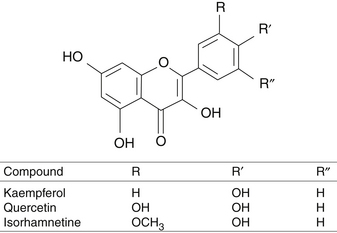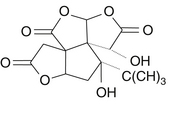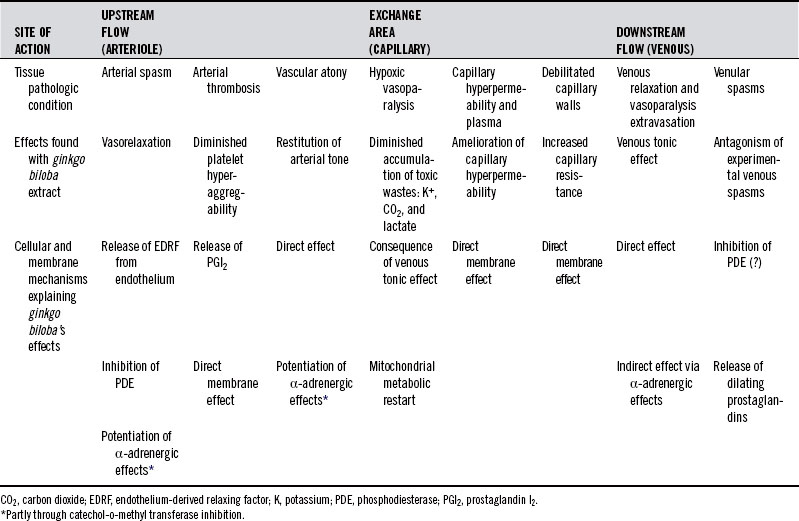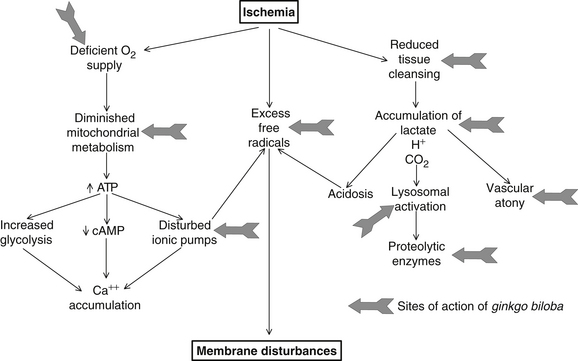Chapter 93 Ginkgo biloba (Ginkgo Tree)
Ginkgo biloba (family: Ginkgoaceae)
Common names: ginkgo tree, maidenhair tree
 Chemical Composition
Chemical Composition
The active components of ginkgo leaves are the ginkgo-flavone glycosides or ginkgo heterosides (flavonoid molecules with sugars attached, which are unique to the ginkgo), several terpene molecules unique to ginkgo (ginkgolides and bilobalide), and organic acids.1
Ginkgo biloboa extract (GBE) is often standardized to contain 24% flavone glycosides, as these molecules represent a convenient analytic reference group. Although they play a major role in the pharmacologic activity of GBE, other components are also important. The three major backbone flavonoids of the G. biloba flavonols are quercetin, kaempferol, and isorhamnetine (Figure 93-1). The glucoside components are glucose and rhamnose, which are present as single sugars or disaccharides.
Other significant flavonoid components of the extract include proanthocyanidins, largely composed of dimers and oligomers of delphinoidine and cyanidine. The major terpene molecules of GBE, which account for 6% of the extract, are the ginkgolides and bilobalide (Figure 93-2). These substances are unique to ginkgo and are not found in any other plants. Other constituents of GBE include a number of organic acids. These compounds contribute valuable properties to the extract by making the usually water-insoluble flavonoid and terpene molecules of ginkgo water soluble.
 History and Folk Use
History and Folk Use
The ginkgo tree was brought to America in 1784 to the garden of William Hamilton near Philadelphia. The ginkgo is now planted throughout much of the United States as an ornamental tree. The ginkgo, which is the tree most resistant to insects, disease, and pollution, is frequently planted along streets in cities.1 The first green growth to reappear at the center of Hiroshima in 1946 was the sprout of a ginkgo tree that grew to be a normal, full-size tree.2
Ginkgo leaf extracts are now among the leading prescription medicines in both Germany and France, where they account for 1% and 1.5%, respectively, of total prescription sales. In America, it was the top-selling botanical medicine in 1999 with $148 million in sales.3
 Pharmacology
Pharmacology
The GBE extract standardized to contain 24% ginkgo flavone glycosides has demonstrated remarkable diverse pharmacologic effects. Interestingly, the total extract is more active than single isolated components.1,4 This suggests synergism between the various components of GBE, an explanation that is well supported in more than 400 clinical and experimental studies using the extract.1,4–6
General Effects
GBE exerts profound, widespread tissue effects, including membrane-stabilizing, antioxidant, and free radical-scavenging effects. GBE also enhances the use of oxygen and glucose.1,4,5
Red blood cells provide excellent models for evaluating the effects of substances on membrane functions. Red blood cell studies using GBE demonstrated that, in addition to directly stabilizing membrane structures and scavenging free radicals, GBE also enhanced membrane transport of potassium into the cell and sodium out by activating the sodium pump. In essence, GBE leads to better membrane polarization. This effect is particularly important in excitable tissues such as nerve cells.1,4 GBE prevents metabolic and neuronal disturbances in experimental models of cerebral ischemia.1,4,7–10 It accomplishes this by enhancing oxygen utilization and increasing cellular uptake of glucose, thus restoring energy production.
GBE also helps to reestablish effective tissue perfusion during hypoxia. Particularly interesting is GBE’s ability to normalize the circulation in areas most affected by microembolization, namely, the hippocampus and striatum.1,4 Discussion of additional nervous tissue actions of GBE is incorporated later in the section on “Clinical Applications”. Briefly, GBE promotes an increased nerve transmission rate, improves synthesis and turnover of brain neurotransmitters, normalizes acetylcholine receptors in the hippocampus (the area of the brain most affected by Alzheimer’s disease),1,4 and inhibits β-amyloid deposition.11
Vascular Effects
The mechanisms of GBE’s vascular effects were investigated using a number of in vivo and in vitro techniques (Table 93-1).1,4 Isolated vessel techniques allowed for separation of GBE’s effects on different parts of the vascular system (e.g., arterial, arteriolar, microcirculatory, venular, and venous components), whereas in vivo studies provided information on the total circulatory phenomena (i.e., GBE’s ability to increase the perfusion rate to various regions).
In general, GBE exerts its vascular effects primarily through its effects on the lining of the blood vessels (vascular endothelium) and the system that regulates blood vessel tone. Its vasodilating action is explained by direct stimulation of the release of endothelium-derived relaxing factor and prostacyclin (a beneficial prostaglandin). In addition, GBE inhibits 3′,5′-cyclic guanosine monophosphate phosphodiesterase, an enzyme that results in relaxation of blood vessels.1,4
On the venous system, GBE stimulates greater tone, thus aiding the dynamic clearing of toxic metabolites that accumulate during ischemia (Figure 93-3).1,4
GBE normalizes circulation by producing tonic effects. These effects are much more apparent in an ischemic vascular area than on a normally perfused area.12 However, despite intense investigation, many of GBE’s tonic effects on vascular components are still largely unexplained. GBE can simultaneously combat the phenomena resulting from vascular spasm and, with the same efficiency, restore circulation to areas subject to vasomotor paralysis.
Another prime clinical application of GBE’s effects on vascular endothelium is early stage diabetic nephropathy. In one 8-week clinical trial, in the GBE group, the brachial arterial endothelium-dependent dilation increased from 4.91% before treatment to 6.78% after treatment, whereas the level of von Willebrand factor decreased from 182% to 128.5%, and nitrous oxide increased from 50.16 to 70.65 µmol/L.13
GBE also protects against endothelial damage caused by oxidized low-density lipoprotein cholesterol, thereby preserving endothelial adhesive properties and disruption of ionic homeostasis.14
Platelet Effects
GBE and isolated ginkgolides have profound effects on platelet function, including inhibition of platelet aggregation, adhesion, and degranulation.5 These effects appear to be due to direct membrane and antioxidant effects, increased synthesis of prostacyclin, and an antagonism of a substance known as platelet-activating factor (PAF).
GBE and the ginkgolides were shown to be potent inhibitors of PAF.5,15–17 PAF is a potent stimulator of platelet degranulation and is involved in many inflammatory and allergic processes, including neutrophil activation, increased vascular permeability, smooth muscle contraction including bronchoconstriction and reduction in coronary blood flow. GBE and ginkgolides compete with PAF for binding sites and inhibit the various events induced by PAF.1,4,18,19 These actions may be responsible for many of GBE’s clinical effects. Interestingly, despite these effects on PAF, GBE exerts no inhibition of platelet aggregation in humans.
Absorption and Distribution of Ginkgo biloba Extract
The pharmacokinetics (absorption, distribution, and elimination) of GBE were studied in rats using radiolabeled extracts.1,4,5 After oral administration, at least 60% of the radiolabeled extract was absorbed. Because blood levels peaked after 1.5 hours, upper gastrointestinal tract absorption was suspected.
Complexing GBE with phospholipids showed that the bioavailability of quercetin, kaempferol and isorhamnetin were increased significantly, indicating these preparations might offer the best clinical response.20 For central nervous system effect, complexing GBE with phosphatidylserine may prove superior to phosphatidylcholine (discussed in “Cerebral Vascular Insufficiency and Impaired Mental Performance”).21
 Clinical Applications
Clinical Applications
Cerebral Vascular Insufficiency and Impaired Mental Performance
Cerebral vascular insufficiency is an extremely common condition in the elderly of developed countries due to the high prevalence of atherosclerosis (hardening of the arteries). In well-designed studies, GBE displayed a statistically significant regression of the major symptoms of cerebral vascular insufficiency and impaired mental performance. The following symptoms were reported*:
In a comprehensive review, the quality of research on more than 40 clinical studies with GBE in the treatment of cerebral insufficiency was analyzed. The results indicated that GBE was effective in reducing all symptoms of cerebral insufficiency, including impaired mental function (senility). The quality of research was comparable to Hydergine (dihydroergotamine), a Food and Drug Administration-approved drug used in the treatment of cerebral vascular insufficiency and Alzheimer’s disease. Eight studies stood out as being extremely well designed and are summarized in Table 93-2.16–19,23–25
TABLE 93-2 Studies Demonstrating the Significant Regression of the Major Symptoms of Cerebral Vascular Insufficiency Through the Use of Ginkgo biloba Extract
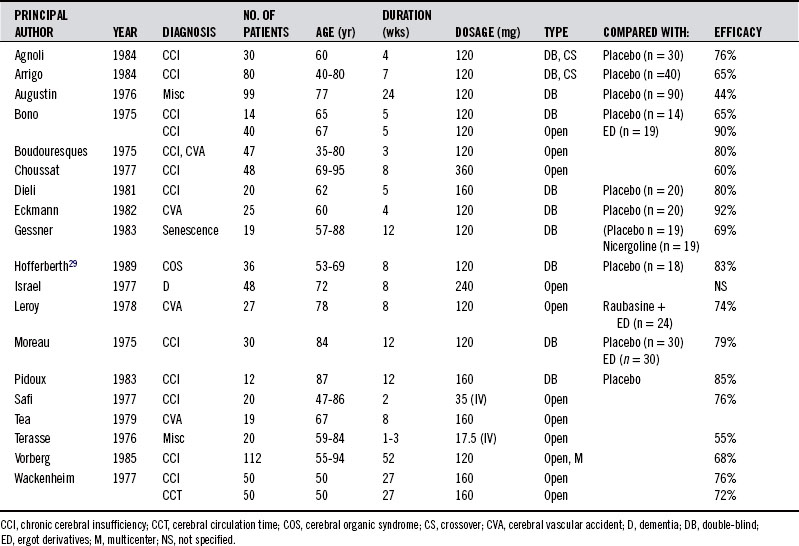
It appears that by increasing cerebral blood flow, and therefore, oxygen and glucose utilization, GBE offers relief from these presumed “side effects” of aging and may offer significant protection against their development. Furthermore, G. biloba’s antiaggregatory effect on platelets offers additional protection against a stroke. This was supported in a clinical study of poststroke patients, which demonstrated that GBE improved blood flow and blood viscosity.26 In another study using dynamic susceptibility contrast-enhanced magnetic resonance imaging, elderly human subjects taking a modest dosage of 60 mg of GBE for 4 weeks experienced a significant increase of global cerebral blood flow, 15% in white matter and 13% in gray matter.27
In addition to improving blood supply to the brain, experimental and clinical studies showed that GBE increased the rate at which information was transmitted at the nerve cell level.28–30 One study investigated the effects of acute doses of standardized GBE on memory and psychomotor performance in 31 healthy volunteers who were 30 to 59 years old. The study was randomized, double-blind, and placebo-controlled with a five-way crossover design. Ginkgo improved working memory in all volunteers, especially those who were 50 to 59 years old.31 However, GBE’s memory-enhancing effects are not limited to the elderly. In another double-blind study, the reaction time in healthy young women performing a memory test was improved significantly after administration of GBE.30 GBE complexed with phosphatidylserine might show even better results in these sorts of applications. In one study, 28 healthy young participants received 120 mg GBE, 120 mg GBE complexed with phosphatidylserine (Virtiva), 120 mg GBE complexed with phosphatidylcholine, and a matching placebo, on separate days 7 days apart. Cognitive performance was assessed using the Cognitive Drug Research computerized test battery and Serial Subtraction tasks immediately before dosing and at 1, 2.5, 4, and 6 hours thereafter. In keeping with previous research utilizing the same methodology, 120 mg of GBE was not associated with markedly improved performance on the primary outcomes. However, administration of Virtiva resulted both in improved secondary memory performance and significantly increased speed of memory task performance across all of the postdose testing sessions. Enhancement following GBE complexed with phosphatidylcholine was restricted to a modest improvement in secondary memory performance, which was restricted to one postdose time point.21
Stay updated, free articles. Join our Telegram channel

Full access? Get Clinical Tree


